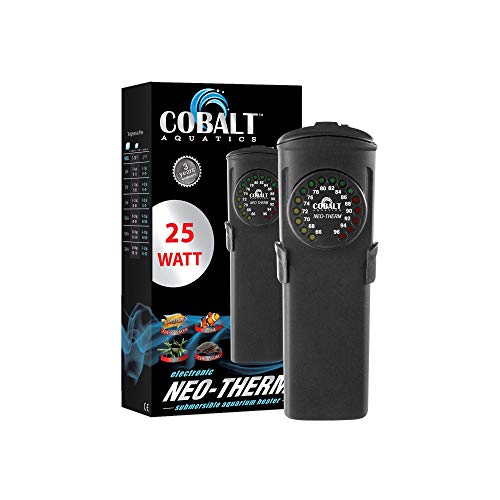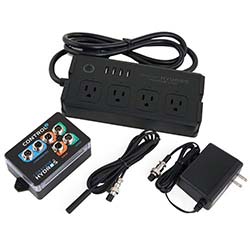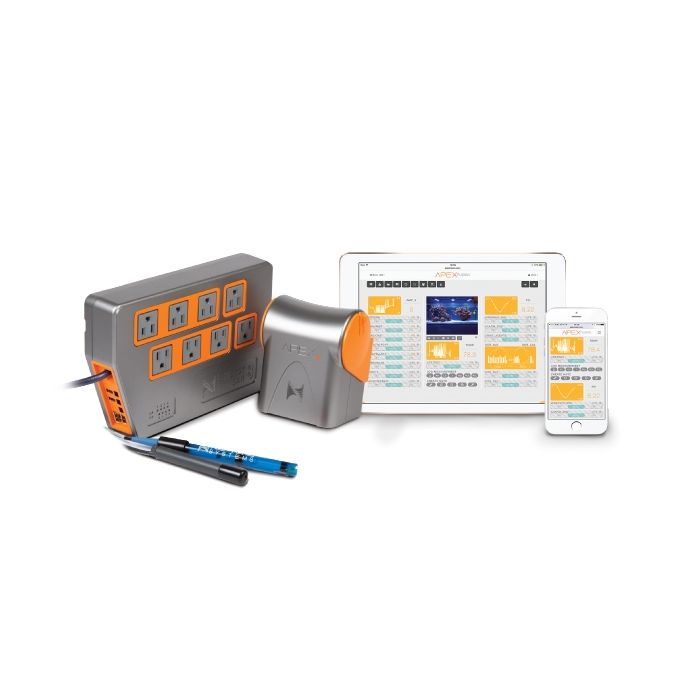The best saltwater aquarium heater would be the one that never fails. That’s obviously not possible. Heaters are relatively inexpensive and simple devices. Unfortunately, when one fails it won’t be long before your tank is either cooked or a popsicle.
Even the best saltwater aquarium heater is a failure-prone device. Constant cycling of a mechanical thermostat will eventually lead to it sticking “on” or “off”.
The most reliable aquarium heater shouldn’t necessarily be the only factor to consider when buying one. My approach is using a failsafe system. If one piece of the system for heating your fish tank fails it won’t destroy your aquarium. I’ll go over how you can set up a failsafe aquarium heater system later in the article.
You should also consider replacing your heater on a regular basis. Some people recommend doing this every year. Aquarium heaters are relatively inexpensive and heater failure can be devastating.
In this review and guide, we’ll cover the most reliable saltwater aquarium heaters. We’ll also cover some additional equipment to help keep a failure from ending in disaster.
The other consideration to keep in mind is the on/off accuracy range. Rapid on and off switching can lead to reduced lifespan but help keep temperature fluctuations small. This comes at the sacrifice of keeping tight control on your fish tank temperature. Keeping all parameters in your aquarium as consistent as possible is best for your aquarium. Fluctuation of a degree or two overall isn’t going to stress your fish or corals so this is a reasonable tradeoff.
Aquarium Heater Size Calculator
To determine the right size/wattage heater for your aquarium you need to know more than just the size of your aquarium. You need to account for any water you might have in your sump, as well as the typical temperature in your house and what temperature you’re wanting to maintain in your tank.
A Note on Heater Accuracy
Aquarium heaters are not typically very expensive devices which means that accuracy isn’t going to be lab grade. This makes sense for the price point so keep this in mind. To account for this verify the temperature you set on your thermostat with a separate thermometer. If you find that it’s a little inaccurate you can simply adjust the temp on the heater accordingly. Some heaters like the Eheim Jager allow you to actually calibrate the heater. You can adjust it to the temperature you verify which is a nice feature.
The Best Heater for Saltwater Aquariums
Cobalt Aquatics Neo-Therm
The Neo-Therm is a unique heater from Cobalt Aquatics. Its heater design is a flat plastic shell. The others use tube form factors. This may be handy for nano tanks with sumps incorporated into the rear of the aquarium or other situations where space is a bit cramped. The plastic case is also pretty durable and less likely to break. The controller is digital and EXTREMELY accurate with its on/off range accuracy. For all intents and purposes it will maintain a flat temperature with no fluctuation. Larger heaters will come in a daisy chain configuration of smaller heaters. This can be beneficial for spreading the units out a bit and can help with tight spaces in addition to its slim size. These heaters are pretty expensive but you do get a pretty high quality piece of equipment for your money.
Eheim Jager TruTemp
The Eheim Jager is a very popular glass-bodied heater and the one that I’ve personally used for years. I’ll admit that I did have a failure once with a Jager where the glass cracked and the heater shorted out in the tank. Fortunately, it happened while I was sitting in the room with my tank. I heard a pop and when I looked up I saw a puff of smoke coming out of the tank. Thankfully nothing was harmed in the aquarium. I immediately ran to my local fish store to pick up a replacement. I considered going with another brand but ultimately I bought another Eheim and that’s the brand I’m running today.
The Eheim uses a mechanical thermostat for turning on and off the heater. This is a somewhat less than ideal method. Mechanical cycling causes wear. The on/off range is approximately 1/2 degree which is pretty tight. That means your tank temp will only fluctuate by 1/4 degree above or below your set temp. Pretty darn impressive for old school technology.
Finnex HMA Titanium Analog Control Heater
The Finnex HMA Titanium heaters are surprisingly affordable making them a very popular heater. The titanium tube is obviously far more durable than glass. The controller is analog. It is inline on the cord and not on the heater itself which can be a little easier to access. In addition to the titanium construction, the on/off range accuracy of this heater is acceptable. The HMA has a total temperature swing of 2 degrees. It should be noted that this heater is fairly slow to heat your tank. Once it’s up to temp it keeps it pretty spot on. Another point to note is that rapid cycling to maintain accurate temperatures has a penalty in a shorter lifespan for the heater components. This means the lifespan of this heater may not be that great.
Finnex HPC Digital Submersible Aquarium Heater
The Finnex HPC is a great glass-bodied heater that includes a digital probe external to the heater. It includes a plastic sleeve around the heater to help protect the glass which is a nice addition. There’s an integrated digital display that shows the current aquarium water temperature and the power switch is built into the power cord instead of on the submersible body for easier access. This design makes a lot of sense in my mind since you’re able to keep the probe further away from the heating element. That said, most heaters don’t go this route and have managed to be reasonably accurate. A digital thermostat should be a more reliable way of controlling the heater. A digital thermostat won’t wear out with cycling on and off. Other parts of the heater will still suffer damage over time from cycling though.
The Finnex has an on/off range of approximately 1 degree. This means that it will fluctuate half a degree above and half a degree below your set temperature.
Hygger HGD921 Aquarium Water Heater
The Hygger HGD921 is a much more advanced heater that is more expensive. The expense gets you some nice safety features such as over-temp protection to protect from overheating your aquarium, anti-dry protection which protects the heater from damage if it comes out of the water while still on, redundant temperature probes, and it can rapidly recover temperature after a prolonged power failure to bring the water temp back up to safe levels as quickly as possible. It also employs an inline digital controller on the power cord.
This unit has an on/off range of 1 degree for a +/- of 1/2 degree which is above average and very nice for increased temperature stability.
Dissecting The Best Saltwater Aquarium Heater Review Results
The Cobalt Aquatics Neo-Therm comes out on top as the best design and most accurate heater but at a price.
The Finnex HMA Titanium Digital Control Heater was particularly impressive. It has a super tight on/off range accuracy and it’s very affordable. Combine that with the sturdy titanium construction and it’s a solid winner at a bargain price.
The Eheim Jager TruTemp is an excellent budget choice. In fact, this is the heater that I run on my aquarium. I chose the Eheim due to its reasonable reliability and low price. Since I like to replace heaters often to eliminate failure points, it was the obvious pick for me when combined with my Neptune Apex.
I’d say that either choice is a winner and you should decide based on which fits best in your budget. Given that it’s a good idea to swap out heaters regularly to account for failures, you may want to go with the cheaper option.
Making Your Aquarium Heater As Reliable And Failsafe As Possible
Having the best saltwater aquarium heater means absolutely nothing if it fails and cooks your tank. A lot of time, effort, and money goes into your aquarium. Not to mention the lives of your fish and corals. Ensuring the safety of your tank from heater failure is very important. I’ve already mentioned replacing your heater regularly to avoid failures. That’s a pretty simple way to handle the problem but not failsafe. You can always get a dud heater like I did once with an Eheim. That wouldn’t be surprising to have happen in an relatively inexpensive device.
Failsafe Heater Setup Option 1
An inexpensive way to go would be to use a heater controller like the Inkbird ITC-306A WiFi Temperature Controller. It comes with 2 digital probes and two controllable outlets based on the temperature reading. The more accurate heaters at holding a consistent temp would be a great fit with the Inkbird. The Finnex is great at holding a consistent temp and the Inkbird can provide a failsafe range to prevent the heater from cooking your aquarium in the event it gets stuck on.
The inclusion of WiFi gives you instant notification of any problems that need immediate attention.
Failsafe Heater Setup Option 2
A powerful step up would be to get a CoralVue Hydros 2 to control your heater. The Hydros 2 will maintain a very consistent temperature and the choice of the heater is a little less critical. With the Hydros 2, I’d use the thermostat within the heater as the failsafe temperature switch. The Hydros 2 can also sound an alert if there’s a problem.
I suspect the Hydros system from CoralVue will grow to rival the Neptune Apex before long. We’ll see how that goes over time.
Failsafe Heater Setup Option 3
The ultimate solution would be to use a Neptune Apex in the same way as the Hydros 2. The Neptune is more expandable and more popular than the Hydros line but the Hydros is still a very capable aquarium controller. The Neptune can monitor power usage through its power bars and alert you to unusual situations. One situation is the heater drawing more or less power than normal. This could be an indication of the heater beginning to fail. Pairing it with another heater of a different brand would but ultra redundant and probably a bit of overkill. If you were away on vacation though you’d be able to survive a heater failure. You wouldn’t need to worry about figuring out how to get a replacement heater. The Neptune can alert you via email or text about an issue. In addition, it has an audible alert from the controller itself. Upgraded versions of the Hydros 2 can perform this task as well. In my opinion, the best saltwater aquarium heater solution is this one.
What is the best type of aquarium heater?
The 2 main types of aquarium heaters are analog and digital. Of these 2 types, digital is more reliable and accurate.
Analog heaters rely on moving parts to activate the switches. Over time these mechanical parts will wear out and cause a failure. Whether the failure is with the heater becoming stuck in the on position or off position, you will likely end up with a huge tank crash and lots of dead fish and corals.
Digital temperature sensors tend to be more accurate in addition to being more reliable which makes them the preferred choice. Unfortunately, digital heaters aren’t perfect either. All heaters will fail eventually. Due to the harm that can befall your reef tank if a heater fails, it’s still smart to replace your heaters once a year.
When should I replace my aquarium heater?
It’s smart to replace an aquarium heater once a year or so. Given the devastating effects of a heater failure and the relatively small cost, it’s worth taking this preventative step.
You should also replace your heater if you notice it having any trouble maintaining the temperature within 2 degrees of what you have set. 2 degrees is the outer limit of accuracy of typical heaters and heaters that fall outside this range are likely failing as well as creating a less stable environment for your fish and corals.
How accurate are aquarium heaters?
There are 2 types of accuracy to be concerned with regarding submersible aquarium heaters.
- Range
- Calibration
The range is how high or low the heater will allow the temperature to fluctuate. Cobalt Aquatics NeoTherm is the most accurate in this regard. It can maintain temperatures within a couple of tenths of a degree.
The other accuracy concern is your heater’s calibration from the factory. It’s not uncommon for heaters from various manufacturers to be out of calibration by 2 or 3 degrees. You should test the accuracy of your heater and adjust its calibration if it offers that functionality.
Why do aquarium heaters fail?
The most common cause of submersible aquarium heater failure is not being fully submerged. Aquarium heaters need to be kept fully underwater or at least kept to the suggested waterline indicated on the heater itself.
If a heater becomes too exposed to air it can’t properly radiate the heat it produces away efficiently and it will overheat. Less expensive aquarium heaters will not be able to alert or correct for this and will fail after overheating for an extended period of time.
Are aquarium heaters expensive to run?
Aquarium heaters are fairly inexpensive to run. The wattage listed on the device is typically only used for 1/2 of a day. Heaters don’t stay in the on position all day.
A small 25-watt heater costs less than $12 dollars to run annually while a much more powerful 300-watt heater can cost around $135 dollars a year to run. These amounts are quite low compared to the other associated expenses involved with saltwater aquariums.
For more details on aquarium heater consumption, you should check out the heater usage breakdown provided by our good friends at TheMandarinGarden.com.
Do I leave my fish tank heater on?
You shouldn’t turn your heater off. Your heater will automatically maintain the temperature of your aquarium according to the temperature you set it to on the heater itself.
You should double-check that your heater is accurate, however.
In Conclusion – The Best Heater for Saltwater Aquariums
The Cobalt Neo-Therm is the best saltwater aquarium heater as a stand-alone heater. However, the Finnex HMO Titanium nearly matches it and does so for a substantial discount. That makes it the best saltwater aquarium heater in my opinion. I’m a long-time Ehiem Jager customer and I’m not really disappointed that it didn’t come out on top. It performed very well in this review and has served me well over the years. I’ll most likely be switching to the Finnex HMA Titanium. Not just because it’s so accurate, but also because it’s cheap. Cheap enough that if I feel like I need to toss it in the trash I won’t hesitate (much). I’d be more reluctant to throw out the Cobalt due to its high cost.






